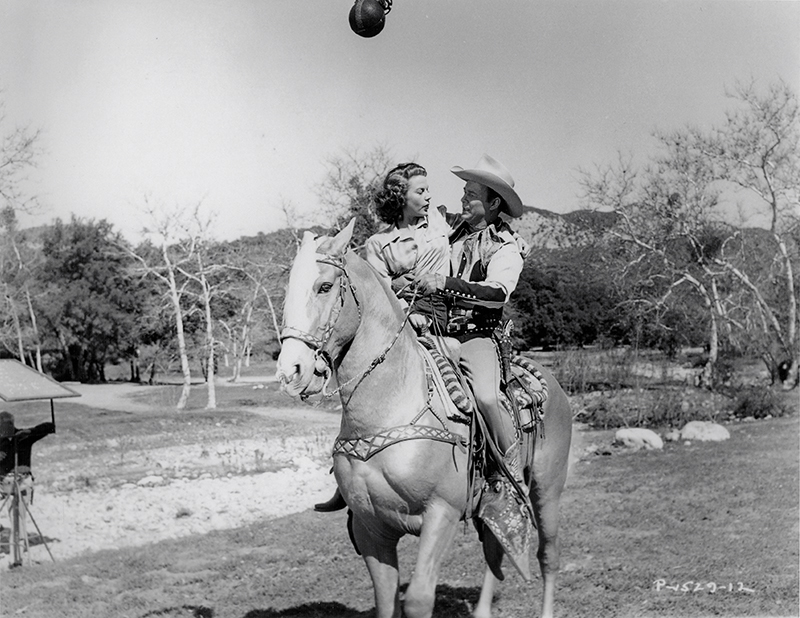|
|


Click image to enlarge
| Download archival scan
Roy Rogers and his wife, Dale Evans, and horse, Trigger, on a film shoot at the Walker Ranch in Placerita Canyon, probably late 1940s. Publicity photo to advertise a movie; unknown which one. Note the boom mic at top and the bounce card at left. Image courtesy of Lisa (Hill) Lynn, granddaughter of Melba Walker Fisher (1916-2015), daughter of Placerita Canyon homesteader Frank Walker (1886-1971).
About Roy Rogers. From The Encyclopedia of Popular Music by Colin Larkin. Leonard Franklin Slye, 5 November 1911, Cincinnati, Ohio, USA, d. 6 July 1998, Apple Valley, near Victorville, California, USA. Raised in the industrial city of Cincinnati, Slye left for California in 1929. He worked on the west coast picking fruit and in New Mexico as a cowhand. After several singing jobs (billing himself as Dick Weston), he formed the Sons Of The Pioneers in 1933 with Bob Nolan and Tim Spencer, later adding fiddle player Hugh Farr and his brother Karl Farr on lead guitar. The group were a pioneering vocal force in country music, specialising in cowboy songs and immaculate harmonies. They performed in many Western movies, with Slye sometimes credited as Dick Weston. As a result of Republic's dispute with Gene Autry, Slye received his first starring role as Roy Rogers, playing a singing congressman in 1938s Under Western Skies. With the Sons Of The Pioneers under exclusive contract to appear in Charles Starrett's films for Columbia Pictures, Rogers was forced to leave the group. Before long, Rogers had replaced Autry as the king of the Westerns, becoming a national hero with his portrayal of the clean-living, straight-talking cowboy. In 1946 his wife Adele died shortly after giving birth to their son, Roy Jnr. On 31 December 1947 he married an actress he met on the set of the movie The Cowboy And The Senorita, Dale Evans. His films, many of which co-starred Evans, included King Of The Cowboys, Son Of Paleface with Bob Hope and Jane Russell, and Hollywood Canteen, in which he sang "Don't Fence Me In." Rogers' four-legged friend, Trigger ("the smartest horse in the movies"), had been ridden by Olivia de Havilland in "The Adventures of Robin Hood" and cost Rogers $2,500. When he and John Wayne jumped off a cliff in 1940's "Dark Command," Hollywood's treatment of horses was severely questioned, and led to the formation of the Society for Prevention of Cruelty to Animals. His movies and television series (100 shows between 1951 and 1957) also featured a loveable, toothless and fearless old-timer, Gabby Hayes. They featured no sex and little violence (he would wing the baddies in black hats), and his wholesome image found favour when he toured UK theatres in the 1950s. High prices are now paid for Roy Rogers memorabilia (to which he wisely gained all the rights), whether it be cut-out dolls, thermos flasks or holster sets. Less successful as a recording artist, Rogers' best known songs include "A Little White Cross On The Hill," "My Chickashay Gal," "Blue Shadows On The Trail," "Pecos Bill," "Stampede," "Lovenworth," "These Are The Good Old Days," a tribute to the past, "Hoppy, Gene And Me" and "Ride Concrete Cowboy, Ride" from the movie Smokey And The Bandit 2. He was backed by the Sons Of The Pioneers in the late 30s, but only Karl Farr would appear on subsequent recordings on which he was accompanied by various studio orchestras. He later found religion, and added spiritual material to his repertoire. Don McLean and San Franciscan rock band Quicksilver Messenger Service were among many non-country acts to record Rogers' famous signature tune, "Happy Trails" (written by Evans), and Rogers revived it with Randy Travis in 1990. His palomino Trigger died in 1965 at the age of 33 and was stuffed and mounted, as referred to in Jimmy Webb's song "P.F. Sloan." Rogers became a successful businessman with a chain of restaurants, and he and Evans confined their appearances to religious ones. He made his first movie in 16 years in 1975, Mackintosh And T.J., while his son, Roy Rogers Jr., made an album, Dusty, in 1983. Rogers was elected to the Country Music Hall Of Fame in 1988, having already gained entry as part of the Sons Of The Pioneers in 1980. He returned to the US country chart with his album Tribute in 1991, which included guest appearances from contemporary country performers. Clint Black helped to revitalize his career, the first time Rogers had accepted help from a man in a black hat. In 1992, a feature-length documentary entitled Roy Rogers, King Of The Cowboys, was shown at the Rotterdam Film Festival. When he died in 1998, Rogers' wealth was estimated at around $100 million.
FW4801: 9600 dpi jpeg, online only.
|
The site owner makes no assertions as to ownership of any original copyrights to digitized images. However, these images are intended for Personal or Research use only. Any other kind of use, including but not limited to commercial or scholarly publication in any medium or format, public exhibition, or use online or in a web site, may be subject to additional restrictions including but not limited to the copyrights held by parties other than the site owner. USERS ARE SOLELY RESPONSIBLE for determining the existence of such rights and for obtaining any permissions and/or paying associated fees necessary for the proposed use.








